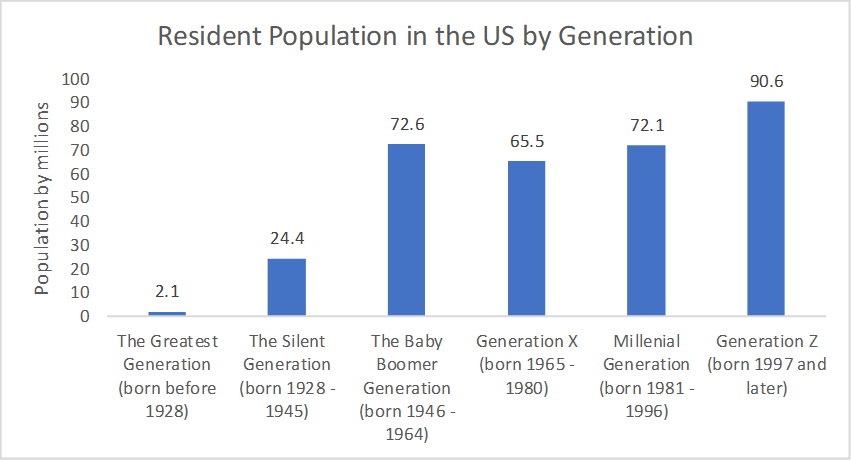According to U.S. Census Bureau, e-commerce in the U.S. during 2019 reached almost $600 billion, a staggering figure when considering the first products sold online occurred only about 25 years ago—about the time when Amazon sold its first book over the internet. Over the past 10 years e-commerce has experienced a compound annual growth rate (CAGR) of 15.3% compared to traditional brick-and-mortar CAGR of just 3.4%. What is more, The Food Institute estimates in the next 10 years, e-commerce will represent a greater than 50% share versus conventional sales in the U.S. (compared to 11% currently).
E-commerce in food and beverage is the fastest growing segment in the e-commerce universe with growth rates reaching over 20% year-over-year, as stated by eMarketer. Although most food shoppers today mainly gravitate towards purchasing primarily non-perishable items in this emergent category (e.g., packaged snack foods like chips and cookies), growth in food e-commerce will likely continue to experience accelerated growth as consumers get more comfortable with purchasing perishable food items online (e.g., fresh fruit, vegetables, bread, etc.). The logistics infrastructure from companies such as Amazon and Walmart have enabled more consumers to receive products faster and cost effectively.
What has contributed to the explosive growth in e-commerce over the past 30 years? Where are we now in the e-commerce lifecycle? And where are we going? These questions will be explored in this series of ongoing e- commerce articles, where The Food Institute will examine the mega trends that have influenced e-commerce and, more importantly, provide key insights into what companies need to know in order to succeed online in the future.
Source: U.S. Census Bureau, E-Commerce Retail Sales
Source: data from eMarketer, May 2019
Demographics & Evolution of the Internet/Technology
Over the past 30 years, we’ve seen a dramatic shift in U.S. demographics—in number, racial diversity, education level, and computer/mobile phone ownership. In 1990, the population of the U.S. was about 250 million with “foreigners” representing 19.7% of the overall population, according to Census Bureau. Today, the population sits at roughly 330 million and “foreigners” represent 23.5%.
Also 30 years ago, those households with access to computers and a high school degree or higher represented only 15.2% and 71.7% of households, respectively; whereas today, almost 90% of households have access to computers (over 80% can access broadband internet) and 87.7% possess a high school degree or higher.
Mobile devices experienced an even faster level of growth over the past 10 years with 96% of Americans now owning a mobile device of some kind, according to Pew Research.
The fierce rise of mobile “smart” devices brought an interesting element to e-commerce. According to Business Insider Intelligence, m-commerce (or shopping through a mobile device) currently represents about 30% of total online sales. It estimates by 2025, m-commerce will represent almost 50% of total online sales. If their estimates are correct, total e-commerce will double from its current level and m-commerce will surpass traditional e-commerce (i.e., computer-based online sales) over the next five to six years.
The Rise of the Gen Z Army
Millennials and Generation Z currently represent about 50% of the U.S. population and will be the biggest influencers in e-commerce over the next decade. Gen Z represents the lion’s share with 91 million people, or 27.7% of the U.S. population, according to Statista. While Millennials grew up with the advent of the internet and cellphones, Gen Z grew up in a world where being “connected” is commonplace—with laptops, e-devices, smartphones, social media, and virtual reality consoles. This generation is more comfortable with technology than any other previous generation and naturally spend more time online with social media, shopping, and entertainment. In fact, the Gen Z cohort has been characterized as “digitally native,” having been exposed to the digital world since they entered the world. For them, technology is a necessity—a way of life and extension of their own selves.
This new generation of e-commerce influencers also possess a very different mindset than previous generations, especially when comparing them to Generation X (born 1965 to 1980) and the Baby Boomer Generation (born 1946 to 1964). Gen Z values individual identity, authenticity, and embrace causes that benefit the greater good—such as the ESG movement (environmental, social, and governance). Purchasing items are a statement of their value system in many cases, and they are not opposed to paying more for products and food that support their values. On the flip side, Gen Z tends to shun tradition and the status quo, or large institutions and organizations that don’t appeal to their sense of identity. In addition, given their racial diversity in the U.S., and connectedness from a global perspective, Gen Z has a greater tendency to embrace the new and unfamiliar—in people, places, and to what they choose to eat/drink.
Source: Statista, June 2019
Big Implications for Food Companies
Because of the complexities in understanding the differences between the generational cohorts, many companies have struggled financially, and some have not survived. Therefore, the implications for our clients at The Food Institute are enormous. Food companies need to learn to adapt and pivot quickly to the changing demographics and technological advances like never before. With expectations of e-commerce doubling in value over the next five to 10 years, companies not only need to adopt a modern e-commerce strategy, they need to understand the psyche of the younger generations, especially Gen Z. The future of e-commerce is looking bright over the next 10 years, but only for those select few companies who implement these strategies successfully.













